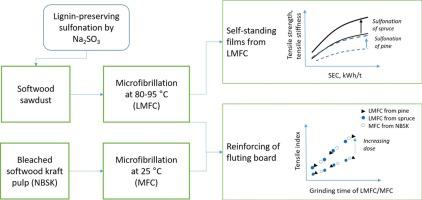Industrial Crops and Products ( IF 5.9 ) Pub Date : 2021-06-16 , DOI: 10.1016/j.indcrop.2021.113738 Ari Ämmälä , Juho Antti Sirviö , Henrikki Liimatainen

|
The production of MFC and CNF has recently been focused on fiber raw materials which, still contain residual lignin instead of bleached chemical pulp fibers. The target of this study was to assess the energy consumption and microfibrillation rate for high lignin containing microfibrillated cellulose (LMFC) produced from non-delignified pine and spruce sawdust directly or after lignin-preserving sulfonation, and evaluate their grade by measuring strength properties of self-standing films made from the LMFCs and by determining their ability to reinforce fluting board. MFC from bleached softwood was used as a reference.
Microfibrillation rate at 80 °C was faster for spruce sawdust than for pine sawdust, i.e., bonding ability (measured as tensile strength of self-standing films) developed faster in spruce LMFC than in pine LMFC. By mild pre-sulfonation of sawdust, corresponding to the sulfonation degree of 0.5−0.6 %, the rate increased further with both softwood species. In similar grinding conditions and equal grinding time, pre-sulfonation did not affect much energy consumption but at a given specific energy consumption the grade of LMFC was better. Due to the high lignin content, mechanical properties of LMFCs could not been developed at as high level than MFC. However, the tensile strength of 100 MPa was possible to achieve for LMFC films using either the equivalent (spruce and sulfonated pine) or even clearly lower amount (sulfonated spruce) of grinding energy than in microfibrillation of bleached Kraft pulp to the same strength.
By comparing the pre-sulfonation of sawdust and the post-sulfonation of LMFC, it was concluded that the main sulfonation effect in grinding was lignin softening, which enhanced cell wall disintegration in microfibrillation. The increased bonding ability of sulfonated lignin and the dissolution of extractives were seen to be secondary effects but not without significance. Pre-sulfonation also improved redispersibility, i.e., the recovery of the mechanical properties of dried LMFCs.
The reinforcing potential was evaluated by dosing LMFCs and MFC without a retention aid into the handsheets made from fluting pulp. The tensile strength of fluting increased almost linearly with an increasing dosage and increasing microfibrillation time. Although the grade of LMFCs, in terms of viscosity and mechanical properties of LMFC films, was lower than that of MFC from bleached softwood, their ability to reinforce fluting board was shown to be equal, indicating lignin present did not interfere the formation of hydrogen bonds. With a 4 % dosage (equaling to the amount of 2–2.5 % within the handsheets) of each LMFC microfibrillated for 120 min, the tensile strength improved by 20 %. Among the tested raw materials, LMFC from spruce sawdust without pre-sulfonation has the greatest potential as a cost-effective reinforcing agent for the paper and board industry. For sulfonated LMFCs should be found applications where their better bonding ability could be better utilized.
中文翻译:

非脱木素云杉和松木屑制成的高木质素微纤化纤维素的能耗、物理性能和补强能力
MFC 和 CNF 的生产最近集中在纤维原料上,这些原料仍然含有残留的木质素,而不是漂白的化学浆纤维。本研究的目的是评估由未脱木质素的松木和云杉锯末直接或在保留木质素磺化后生产的高木质素微纤化纤维素 (LMFC) 的能耗和微纤化率,并通过测量自身的强度特性来评估其等级。 - 由 LMFC 制成的立膜,并通过确定它们增强凹槽板的能力。来自漂白软木的 MFC 用作参考。
云杉木屑在 80 °C 下的微纤维化速率比松木屑更快,即云杉 LMFC 的粘合能力(以自立膜的拉伸强度衡量)比松木 LMFC 发展得更快。通过对锯末进行温和的预磺化,对应于 0.5-0.6% 的磺化度,两种针叶木品种的磺化率进一步增加。在相似的研磨条件和相同的研磨时间下,预磺化对能耗的影响不大,但在给定的特定能耗下,LMFC的等级更好。由于木质素含量高,LMFC 的机械性能不能像 MFC 那样高。然而,
通过比较木屑磺化前和LMFC后磺化,得出研磨中的主要磺化作用是木质素软化,这增强了微纤维化过程中细胞壁的分解。磺化木质素的结合能力增加和提取物的溶解被认为是次要效应,但并非没有意义。预磺化还改善了再分散性,即干燥 LMFC 机械性能的恢复。
通过向由槽纹纸浆制成的手抄纸中加入不含助留剂的 LMFC 和 MFC 来评估增强潜力。随着剂量的增加和微纤维化时间的增加,凹槽的拉伸强度几乎呈线性增加。虽然 LMFCs 的等级,在 LMFC 薄膜的粘度和机械性能方面,低于来自漂白针叶木的 MFC,但它们增强瓦楞纸板的能力被证明是相同的,表明存在的木质素不会干扰氢键的形成. 每种 LMFC 微纤化 4% 的剂量(相当于手抄纸中 2-2.5% 的量)120 分钟后,拉伸强度提高了 20%。在测试的原材料中,未经预磺化的云杉木屑制成的 LMFC 作为纸和纸板行业的经济高效的增强剂具有最大的潜力。对于磺化 LMFC,应该找到可以更好地利用它们更好的键合能力的应用。



























 京公网安备 11010802027423号
京公网安备 11010802027423号